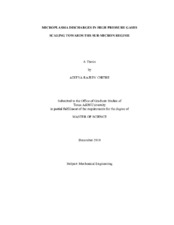| dc.description.abstract | Atmospheric pressure microplasmas are uniquely characterized by their very high energy densities and also by their small discharge sizes. These properties allow for unique applications in plasma processing technologies. We have investigated the operational characteristics of microplasmas at higher energy densities and smaller sizes by operating microplasma configurations at high pressure conditions.
We studied the discharge and analyzed its variation with changes in current and pressure. The discharge was analyzed by microscopic visualization and data from the images and was processed to measure the current density and estimate charged particle density. By increasing the pressure beyond 200 psi and by minimizing the discharge current required for sustaining the plasma, we have been able to achieve discharge sizes of 7 mu m in nitrogen and as small as 20 μm in helium. Optical emission spectroscopic studies were carried out to measure gas temperature and vibrational temperature using the nitrogen 2nd positive system. With increase in pressure, the transition from non-equilibrium plasma to equilibrium plasma was also studied using the OES temperature measurements. iv
Temperature measurements are also used to estimate normalized current densities. Normalized current density results obtained after introducing the corrected effective pressure based on the increased gas temperature are close to the value of 400 mu A /cm^2*Torr^2 obtained for low pressure normal glow discharges in nitrogen.
This research presents further validation of the general operational characteristics of microplasmas being pressure scaled versions of normal glow discharges. Attained energy densities are ten to twenty times higher than in atmospheric pressure microplasmas. Discharge sizes are also significantly smaller, decreasing with increasing pressure, but the scaling is with density ‘nd’ rather than pressure ‘Pd’ due to the increase in gas temperature with pressure, indicating a dependence on collisional processes. We can infer that at higher pressures, the operational characteristics of more complex plasma discharges like dielectric barrier discharges, RF plasmas, etc. follow scaling patterns, transitions and limits similar to the microplasma discharge studied in this thesis. | en |


